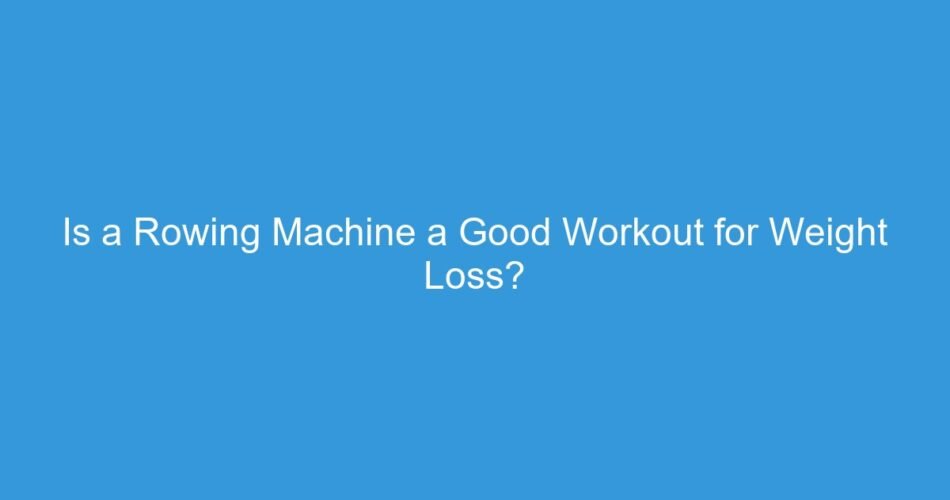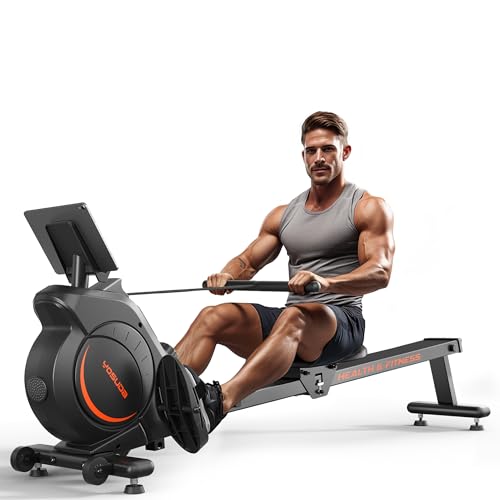The answer is a definitive yes Is a Rowing Machine a Good Workout for Weight Loss and it is often considered one of the most efficient fat-burning machines available due to its total-body, low-impact nature.
Is a Rowing Machine a Good Workout for Weight Loss Yes a rowing machine is an exceptionally effective tool for achieving significant weight loss goals. It stands out from most other fitness equipment because it simultaneously delivers high-intensity cardiovascular training and substantial strength conditioning. This combination maximizes caloric expenditure and improves body composition faster than many traditional cardio routines.
The Mechanics of Caloric Burn and Body Composition
The effectiveness of the rowing machine in burning fat stems directly from its high-demand, low-impact nature. Weight loss requires creating a consistent calorie deficit, and rowing excels at achieving this deficit quickly.
🛒 Recommended Product
According to data from Harvard Medical School, a 185-pound individual can burn approximately 370 calories during just 30 minutes of vigorous rowing. This rate often rivals or exceeds the caloric burn associated with sustained running, but with the critical advantage of being gentle on the joints.
Furthermore, rowing is a highly efficient activity because it requires the recruitment of nearly every major muscle group in the body. The energy demand needed to power this multi-muscle movement results in a significant boost to your basal metabolic rate (BMR), aiding in long-term weight management.
Total Body Engagement: Why Rowing is Efficient
Unlike treadmills or stationary bikes, which are primarily lower-body focused, the rowing machine delivers a true total body workout. This comprehensive muscle engagement is the primary driver of its weight loss efficacy.
The rowing stroke utilizes 86% of the body’s muscles. The action is segmented into a four-phase sequence: the catch, the drive, the finish, and the recovery.
Key muscle group engagement ratios:
- Legs (60%): The initial drive phase is powered primarily by the quads, hamstrings, and glutes, making it an incredibly powerful lower-body strength workout.
- Core and Back (20%): The core stabilizers and abdominal muscles are crucial for maintaining posture and linking the power generated by the legs to the upper body.
- Upper Body (20%): The arms, shoulders, and chest engage during the final finish phase to pull the handle towards the torso, strengthening the upper back and biceps.
This high degree of muscle recruitment ensures that fat is targeted across the entire body, leading to a more balanced and sustainable improvement in body composition.
Rowing vs. Other Cardio Machines
While traditional cardio machines like treadmills and ellipticals are effective for burning calories, rowing offers a unique advantage by combining cardio and resistance work. This dual function is crucial for fat loss because resistance training helps build lean muscle mass, which in turn increases metabolism.
🛒 Recommended Product
Additionally, rowing is uniquely accessible due to its low-impact exercise status. The smooth, seated motion reduces stress on the hips, knees, and ankles, making it an ideal choice for individuals recovering from injury, those with joint pain, or people with high body weight who need a safe starting point.
| Exercise | Estimated Calorie Burn (30 min, 155 lb person) | Primary Muscle Focus | Impact Level |
|---|---|---|---|
| Vigorous Rowing | 316–370 kcal | Full Body (86% muscles) | Low |
| Running (6 mph) | 372 kcal | Lower Body, Core | High |
| Elliptical | 179 kcal | Lower Body, Arms (Less Resistance) | Low |
The data confirms that rowing is comparable to running in terms of caloric expenditure while avoiding the detrimental joint impact associated with high-mileage road running.
Maximizing Weight Loss on the Rower
To optimize the fat-burning potential of the rowing machine, incorporating varied training methods is essential, moving beyond simple steady-state cardio.
High-Intensity Interval Training (HIIT)
HIIT protocols are widely considered the gold standard for maximal fat burning. HIIT involves alternating short bursts of maximal effort with periods of low-intensity recovery.
Implementing HIIT on a rower significantly increases the “afterburn effect” (Excess Post-Exercise Oxygen Consumption, or EPOC). EPOC forces the body to continue burning calories at an elevated rate long after the workout is complete, further enhancing overall weight loss.
Technique and Stamina
Historically, rowing machines (or ergometers) have been a cornerstone of athlete training for decades, especially since the modern air-based Concept2 models gained popularity in the 1980s. Learning proper form is non-negotiable for both efficiency and injury prevention.
Effective weight loss rowing requires:
🛒 Recommended Product
- Maintaining the 60/20/20 power split (legs/core/arms) to ensure total muscle engagement.
- Tracking key metrics like split time (time to row 500 meters) and strokes per minute (SPM) to consistently push performance boundaries.
- Consistency: Aiming for 3 to 5 sessions per week, combining both HIIT bursts and longer, steady-state sessions, is the fastest route to seeing results.
Rowing machines are undeniably powerful resources for anyone committed to losing weight. By delivering total-body strength work and maximal caloric expenditure, they offer a highly efficient path to achieving a healthier body composition. If the question is whether a rowing machine is a good workout for weight loss, the data strongly supports its place as a top-tier fitness solution.
Scientific References & Research
The following peer-reviewed research papers provide additional scientific context:
-
C Crawford et al. (2024).
[B] Indoor Rowing: Your Complete Guide to Training, Programming, and Workouts
[External Link] -
A Ledvinkova (n.d.).
[HTML] Exercise Bike vs Rowing Machine: Which is Better for Weight Loss?
[External Link] -
A Temraz (2022).
The effectiveness of using a rowing machine for developing aerobic capacity and technical skills in rowing
[External Link]
Note: External research links are provided for educational purposes and do not necessarily represent endorsement.
Frequently Asked Questions About Is a Rowing Machine a Good Workout for Weight Loss?
Q. Is rowing considered a high-intensity workout, and how does this affect its fat-burning potential?
A. Rowing can easily be performed at a high-intensity level (HIIT), which maximizes the “afterburn” effect known as EPOC (Excess Post-exercise Oxygen Consumption). This means your body continues to burn calories at an elevated rate even after you finish exercising, making it exceptionally efficient for tapping into stored fat reserves for energy.
Q. How important is proper form on a rowing machine to maximize weight loss results and prevent injury?
A. Proper technique ensures that you effectively engage the largest muscle groups, such as the legs and glutes, which are crucial for generating power and burning the maximum number of calories. Incorrect form shifts the workload to smaller muscles and increases the risk of injury, severely limiting the intensity and duration of your weight loss workouts.
Q. Can rowing alone achieve substantial weight loss, or should it be combined with other factors?
A. While rowing is an excellent tool for increasing activity and calorie deficit, sustainable and significant weight loss is optimized when combined with dietary changes that maintain a consistent calorie deficit. Incorporating resistance training alongside rowing is also beneficial as it helps build muscle mass, which further increases resting metabolism.
Q
A. The amount of time necessary depends heavily on the intensity and the user’s current fitness level, but aiming for 30 to 45 minutes of consistent rowing, three to five times per week, is a great starting point. Focusing on maintaining a challenging pace will ensure you maximize cardiovascular benefits and calorie expenditure within that dedicated time frame.
Q
A. Because rowing is a low-impact activity, it places minimal stress on the joints, unlike running or jumping exercises, making it suitable for individuals carrying extra weight or those with pre-existing joint issues. This low-impact nature allows users to maintain high-intensity workouts for longer durations and more frequently without suffering the common setbacks of orthopedic pain.
Related Articles
What Is the Best Workout Machine for Weight Loss?
Trying to determine what is the best workout machine for weight loss? While several options deliver results, the rowing machine often provides the max…
Do Vibrating Weight Loss Machines Work?
Do vibrating weight loss machines work? The scientific data is clear: while these vibration therapy plates offer proven benefits like muscle stimulati…
Treadmill Workouts for Buttocks: Sculpt and Tone Your Glutes
Getting fit and shaping your buttocks can be challenging. Treadmill workouts might be the solution you need. Treadmill workouts are not just for cardi…
When you purchase a product through Amazon links on EllipticalKing.com, we may earn a small commission at no extra cost to you. This helps support the site and keep our content free.




